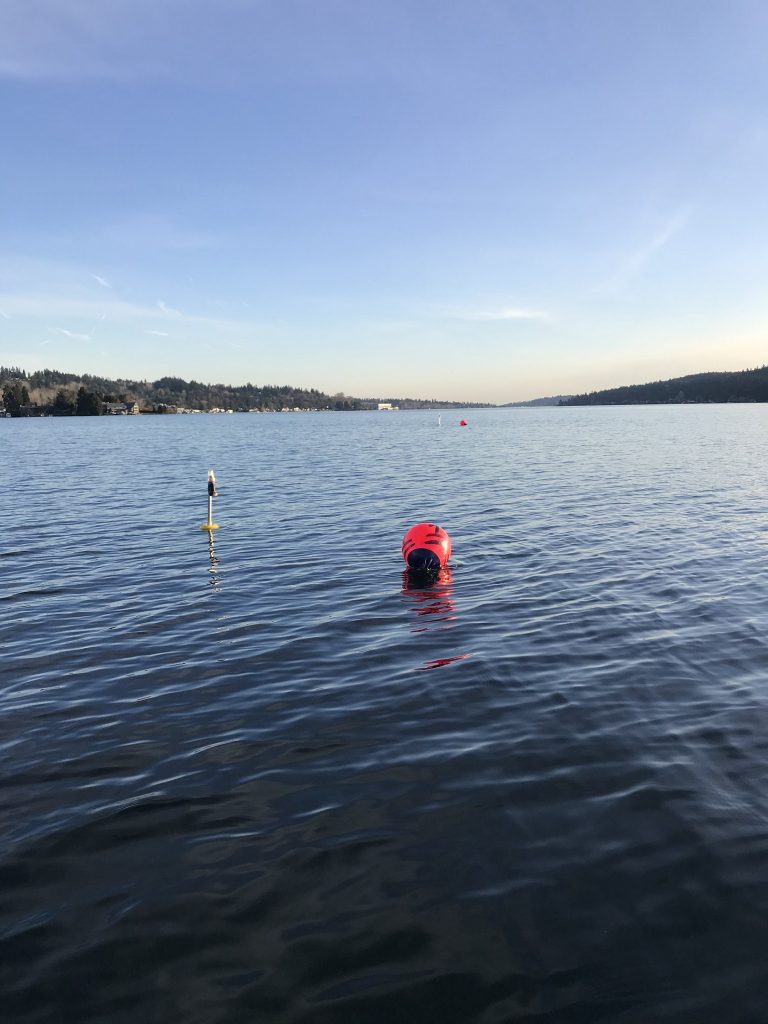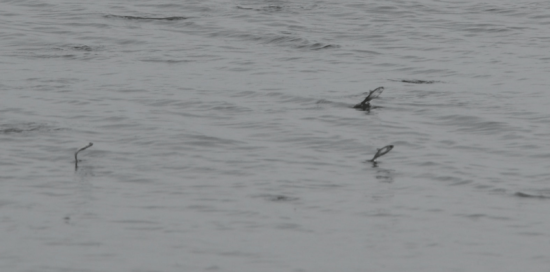
Tribe Begins Warmwater ‘Test Fishery’ On Lake Washington; 2 Pike Reportedly Caught
The Muckleshoot Indian Tribe has begun another warmwater test fishery on Lake Washington by deploying more than a dozen net sets on the east side of Mercer Island this week, alarming fans of the big metro lake’s smallmouth and other spinyray fisheries.
A bass angler out fishing Tuesday came across bright orange buoys in the East Channel from the I-90 bridge south to the Seahawks practice facility and then shared pictures of them as well as a rough map of their locations on Facebook.

“These gill nets are a hundred yards long, and strategically placed in areas with high fish traffic. After doing a quick run from Newport to Coleman Point, I found over 15 gill nets, just in that stretch,” wrote Kai Wikstrom in a post yesterday evening. “These nets need to be removed immediately, and will have an adverse effect on not only the fishery, but the ecosystem itself. Gill nets destroy everything they touch, and will undoubtedly snag anything that swims by them, including many fish species, bird species, turtles, frogs, beavers, and everything else in the Lake Washington ecosystem.
In spring 2019, when similar nets were placed in Lake Sammamish, residents raised concerns about the safety of swimmers and in one particular case, being able to use their boat given the placement of a buoy right next to a dock.
Meanwhile, in a week and a half, a Washington Bass Association tournament is planned on Lake Washington, which at one time was ranked as the 16th best bass water in the Western U.S. and among the top 100 in the country, according to Bassmaster magazine.

So what is going on?
A notice filed this week by the Muckleshoot Tribe provides some details on the effort, including that netting began yesterday and will close this Friday, then recur Mondays through Fridays.
Up to six boats are allowed to work a maximum of 24 3.5- to 6-inch-mesh gillnets with a max length of 300 feet each. Tribal biologists and enforcement officers will monitor it.
Chillingly, two northern pike were reportedly caught in the nets in the first day, according to a state biologist.

The effort is expected to rotate around the lake through June, and is being performed under a federal permit and concurrence that it won’t harm ESA-listed fish, and is being done independently of WDFW.
The Muckleshoots, as well as other tribes in Western Washington, comanage salmon and steelhead with WDFW, a result of 1974’s Boldt Decision which upheld treaty-reserved fishing rights.
At this stage the effort is very similar to what the Muckleshoots have been doing over several months in recent springs on Lake Sammamish, to the east, and to a degree what WDFW is doing in the Lake Washington Ship Canal – initially gauging predator fish populations and what they’re eating.

There are two salmon hatcheries in the Lake Washington watershed and they produce Chinook (listed as threatened under the Endangered Species Act), coho and sockeye for sport and tribal fisheries. As the region’s salmon runs as well as orca populations struggle, the survival of smolts as they rear and migrate through the lakes on their way to Puget Sound has become an increasing concern.
According to a 2016 Muckleshoot report, “fewer than 10 percent of coho smolts” released from WDFW’s Issaquah Salmon Hatchery make it down Issaquah Creek, through Lake Sammamish, the Sammamish Slough, Lake Washington and the Ship Canal to Shilshole Bay on Puget Sound.
Suspicion has naturally fallen on introduced species such as largemouth and smallmouth, along with yellow perch and suddenly burgeoning rock bass populations, but among the “plethora” of piscivores in the system, native cutthroat trout and northern pikeminnow take their share. In the Columbia and Snake, anglers are paid to remove pikeminnows to reduce predation on outmigrating smolts.

Recent years have also seen walleye illegally stocked in Lakes Washington and Sammamish, and it was after spring 2015’s discovery of a dozen or so off Mercer Island by state and tribal biologists that the Muckleshoots began a series of warmwater test fisheries, initially on Washington, then focused on Sammamish.
The tribe considered the release of walleye in the system to be “criminal.”
Some asshat or asshats also dumped in nonnative northern pike in Lake Washington; one was netted in early 2017, another was released in 2018 by a bass angler unsure what to do with it, and now two were caught this morning.
The pike and walleye could only have arrived via livewell or bucket, likely from Eastern Washington where walleye are widespread in the Columbia or, in the case of pike, the state’s northeastern corner or North Idaho, where there are also ongoing attempts to rid the waters of the voracious predator originally from the other side of the Rocky Mountains.

In spring 2019, Muckleshoot nets captured a total of 4,751 fish in Sammamish, and while more than half were native largescale suckers, 892 were smallmouth and 160 were largemouth.
Stomachs were to be sampled and while it’s difficult to find any report on those results, brief details posted on the federal Pacific Coastal Salmon Recovery Fund’s Project and Performance Metrics Database for the effort state, “Data resulting from this project helped quantify the fraction of analyzed diets that was composed of emigrating Chinook and other salmonids. In the lab, stomach contents were examined under a dissecting microscope and prey items were identified to the lowest practical taxonomic unit. Diets were compared pre and post smolt emigration and among species where sample sizes allowed for statistically valid comparisons.”
Messages to both the Muckleshoot Tribe and National Marine Fisheries Service were not immediately returned.
Still, more information about what’s going on – and what may be ahead – is listed in what is called the LOAF, or List of Agreed Fisheries, signed by WDFW and the Northwest Indian Fisheries Commission last spring and governing 2020-21 sport and tribal seasons as well as fish research.
It says the project “will collect additional information on the feasibility and potential impacts of a directed fishery (C&S [ceremonial and subsistence] and commercial) on invasive warm-water fishes in selected portions of the Lake Washington basin, a commercial fishery in the northern portion of Lake Washington, and associated research in Lake Sammamish to estimate population abundance of native and invasive piscivores. The results of this test fishery will inform implementation and management of a full scale commercial fishery directed at warm-water fishes in all areas of the basin that remain off limits to directed commercial fisheries due to concerns over steelhead encounters.”
Steelhead have essentially been missing from the Lake Washington system for several decades following heavy pinniped predation at the Ballard Locks, but if three wild steelhead are caught in nets, the test fishery will close down.
For Washington spinyray enthusiasts, these are increasingly troubling times.
On the one hand, the incredibly altered Lake Washington basin would seem to be the ideal place for introduced gamefish. It’s home to the densest human population in the state, a waterway whose drainage was re-engineered to flow west instead of south and is subject to largescale sewage and stormwater overflows, with an entryway that is lethally warm in summer for returning adult salmon populations that are themselves either mostly introduced or heavily augmented, and ringed by shine-all-night lights, studded with docks and crossed twice by major highways, hardly a natural environment at all and tailor-made for those fisheries in a warming world.
But that is not the direction Washington appears to be heading these days.
In December 2019, WDFW, at the behest of a state legislature concerned about southern resident killer whales – and after previously suspending daily catch and size limits on bass, walleye and catfish in the Columbia and Snake – further liberalized regulations on the species across the state.
And the agency is currently taking comment on a new draft non-native game fish management policy that may, on waters where salmon and steelhead runs are “of concern,” include “active removal” of non-native game fish populations.
Then there was last month’s opinion piece in The Seattle Times from Jeremy James, Muckleshoot Tribal Council member and Fish Commission chair, and WDFW Director Kelly Susewind, calling for the region to save the lake’s “treasured” sockeye.
It’s unclear if that run is salvageable, but powerful forces are not giving up on it or the lake’s other salmon stocks.

